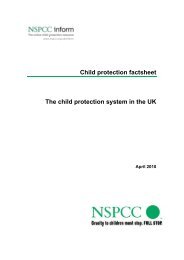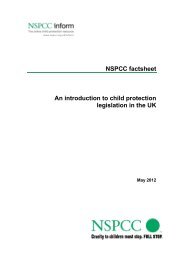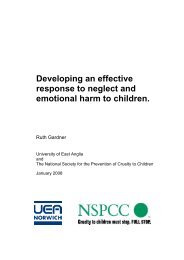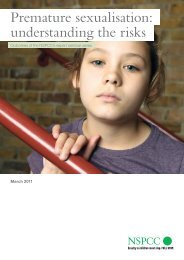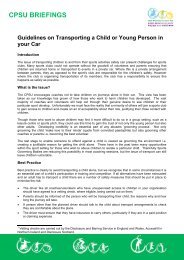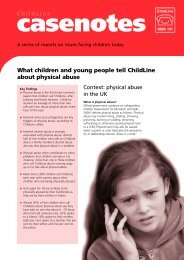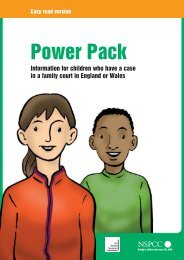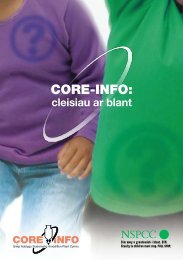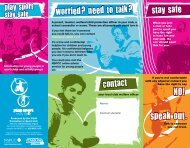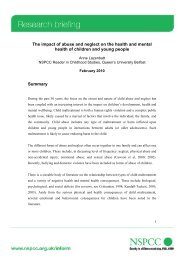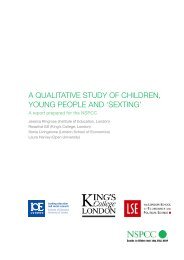Neglect and serious case reviews (PDF, 735KB) - nspcc
Neglect and serious case reviews (PDF, 735KB) - nspcc
Neglect and serious case reviews (PDF, 735KB) - nspcc
You also want an ePaper? Increase the reach of your titles
YUMPU automatically turns print PDFs into web optimized ePapers that Google loves.
themeS aNd learNiNg poiNtS<br />
‘an accident waiting to happen’<br />
3. A thematic analysis of neglect<br />
a qualified <strong>and</strong> experienced social worker. There was confusion <strong>and</strong><br />
delay in responding to the threat of homelessness, <strong>and</strong> the critical<br />
housing issues that the family faced. Even after this tragic accident, this<br />
sense of lack of urgency continued, <strong>and</strong> a year passed without any<br />
formal multi-agency review of progress in safeguarding the surviving<br />
children. This practice was set within a broader context of overwhelming<br />
workload, high staff turnover <strong>and</strong> vacancy rates alongside high numbers<br />
of unallocated <strong>case</strong>s.<br />
• tolerance by professionals of dangerous conditions <strong>and</strong> poor<br />
care: The older siblings had been described as ‘happy <strong>and</strong> playful’<br />
despite smelling of urine, glasses frequently missing or broken, minor<br />
illnesses, <strong>and</strong> school absences. This sense that the children were happy<br />
seems to have allowed agencies to avoid action. This was combined<br />
with a professional tolerance of extremely poor, cramped <strong>and</strong> unsafe<br />
living conditions. The children’s welfare was thought to be ‘good enough’<br />
<strong>and</strong> the mother considered to be ‘just about’ coping without any clear<br />
sense of what this meant in relation to the children’s development or<br />
immediate safety.<br />
‘An accident waiting to happen’ was the way that many of these <strong>case</strong>s were described.<br />
The overview reports for this group of <strong>serious</strong> <strong>case</strong> <strong>reviews</strong> often conclude that ‘noone<br />
could have predicted the chain of events leading to (the child’s) death’. While<br />
the precise circumstances of these accidents were often unpredictable, the reports do<br />
convey the sense that the risk of accidental harm from some source was high, due to<br />
either the precarious living conditions <strong>and</strong>/or the inadequate level of supervision from<br />
the caregiver. Deprivation <strong>and</strong> unsafe care provided a dangerous environment for these<br />
children as one overview report noted:<br />
‘Children from deprived backgrounds are at a much higher risk of accidents than<br />
those from better off households – 13 times more likely to die from accidental injuries<br />
<strong>and</strong> 37 times more likely to die because of smoke, fire or flames’ (Staying Safe: a<br />
consultation document: DCSF, 2007).<br />
Many reports commented on chaotic living conditions, <strong>and</strong> unsuitable housing, which<br />
in at least one <strong>case</strong> included inappropriate <strong>and</strong> dangerous temporary accommodation<br />
for the family, which posed a particular fire risk. High rise accommodation created<br />
problems regarding lack of play facilities, <strong>and</strong> supervision of children ‘playing out’ in<br />
the communal areas, or in the street. There was often a sense of a lack of boundaries;<br />
both in the physical sense of inadequate fences <strong>and</strong> gates, but also in relation to what<br />
the children were allowed to do, <strong>and</strong> the times they were allowed to stay out until. There<br />
were <strong>serious</strong> <strong>case</strong> <strong>reviews</strong> undertaken where young children were playing unsupervised<br />
57




